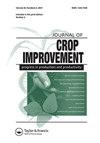雨季和旱季木薯接穗-木薯砧木嫁接对木薯生长和根系产量的影响
IF 1.5
Q3 AGRONOMY
引用次数: 0
摘要
摘要:提出了木薯(Manihot esculenta Crantz)砧木嫁接Manihot glaziovii接穗的方法,以提高木薯根产量,并作为克服木薯花叶病(CMD)问题的一种临时方法。本研究比较了未嫁接的KU50和作为欠砧木嫁接的牛蒡子与glziovii、KU50和HB80接穗的表现。KU50和HB80是已释放的肉苁蓉品种。研究采用随机完全区组设计(RCBD),在泰国两个季节(旱季和雨季)进行了4个重复。嫁接后的植株比未嫁接的植株大。与未嫁接对照相比,嫁接使鲜根产量(旱季)和干物质含量(旱季)分别提高了25%和37%,干物质含量(雨季)分别提高了19%和42%。净光合作用(Pn)、气孔导度(gs)和生长参数表明,嫁接植株在旱季比未嫁接植株具有更高的光合能力和更旺盛的生长。Pn和gs与植株各生育期生长和生产力参数的相关系数在旱季显著,而在雨季不显著。本研究表明,M. glaziovii与木薯嫁接可以改善木薯的生长和根产量。本文章由计算机程序翻译,如有差异,请以英文原文为准。
Evaluation of manihot glaziovii scion-cassava understock grafting for cassava growth and root yield during rainy and dry seasons
ABSTRACT Grafting of cassava (Manihot esculenta Crantz) understocks with scions from Manihot glaziovii was proposed to improve the cassava root yield and as a temporal approach to overcoming the problem of cassava mosaic disease (CMD). This work compared performance of nongrafted KU50 with M. esculenta grafted as understock with M. glaziovii, KU50 or HB80 scions. KU50 and HB80 are released M. esculenta varieties. Work was conducted in the field using a randomized complete block design (RCBD) with four replicates in two seasons (rainy and dry seasons) in Thailand. The M. glaziovii grafted plants were larger than nongrafted controls. Grafting also increased fresh root yield by 25% (dry season) and 37% (rainy season) and dry matter content by 19% (dry season) and 42% (rainy season) over the nongrafted controls. Net photosynthesis (Pn), stomatal conductance (gs) and growth parameters indicated that the grafted plants had a higher photosynthetic capacity and more vigorous growth than nongrafted controls during the dry season. Correlation coefficients of Pn and gs with growth and productivity parameters at different ages of the plant were highly significant during the dry season but not in the rainy season. This study demonstrated that M. glaziovii–cassava grafting improved cassava growth and root yield.
求助全文
通过发布文献求助,成功后即可免费获取论文全文。
去求助
来源期刊

Journal of Crop Improvement
Multiple-
CiteScore
3.30
自引率
7.70%
发文量
42
期刊介绍:
Journal of Crop Science and Biotechnology (JCSB) is a peer-reviewed international journal published four times a year. JCSB publishes novel and advanced original research articles on topics related to the production science of field crops and resource plants, including cropping systems, sustainable agriculture, environmental change, post-harvest management, biodiversity, crop improvement, and recent advances in physiology and molecular biology. Also covered are related subjects in a wide range of sciences such as the ecological and physiological aspects of crop production and genetic, breeding, and biotechnological approaches for crop improvement.
 求助内容:
求助内容: 应助结果提醒方式:
应助结果提醒方式:


